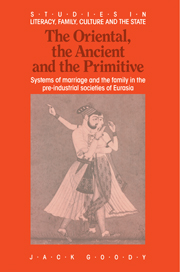 The Oriental, the Ancient and the Primitive
The Oriental, the Ancient and the Primitive Published online by Cambridge University Press: 09 January 2010
The Arab world constitutes a vast domain in time and space, but one which displays some remarkable similarities through the application of Islamic law and custom. Nevertheless there are considerable differences not only among the various schools and regions but in particular between the nomadic Bedouin of the desert, with their ‘tribal’ organisation based on the solidarity of the lineage, and the settled populations, the peasantry in the villages, some with tribal affiliations, and the merchants in the towns. Clearly different strategies of heirship obtain among nomadic peoples, where land was indivisible and held largely in common and where livestock are easily split up into smaller but self-reproducing parcels, than in rural or urban situations where rights in land, in houses or in enterprises have to be reallocated in rather different ways.
This tripartite division of the population is neither new nor confined to the Arabs, but goes back to the coming of agriculture to West Asia, long before the coming of Islam. Both the continuity and the diversity have to be borne constantly in mind when thinking of kinship, marriage and the family among the Arabs from, say, the fourth century AD. For there is once again a tendency to foreshorten the historical sequence, and in particular to look upon Mohammed himself as a point of transition between the tribal and the settled, between the solidarity ('asabiyya) of the desert lineages and the domestic, familial patterns of the town and even of the settled, farming hinterland.
To save this book to your Kindle, first ensure [email protected] is added to your Approved Personal Document E-mail List under your Personal Document Settings on the Manage Your Content and Devices page of your Amazon account. Then enter the ‘name’ part of your Kindle email address below. Find out more about saving to your Kindle.
Note you can select to save to either the @free.kindle.com or @kindle.com variations. ‘@free.kindle.com’ emails are free but can only be saved to your device when it is connected to wi-fi. ‘@kindle.com’ emails can be delivered even when you are not connected to wi-fi, but note that service fees apply.
Find out more about the Kindle Personal Document Service.
To save content items to your account, please confirm that you agree to abide by our usage policies. If this is the first time you use this feature, you will be asked to authorise Cambridge Core to connect with your account. Find out more about saving content to Dropbox.
To save content items to your account, please confirm that you agree to abide by our usage policies. If this is the first time you use this feature, you will be asked to authorise Cambridge Core to connect with your account. Find out more about saving content to Google Drive.